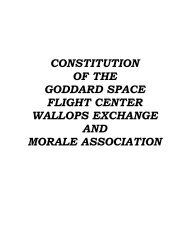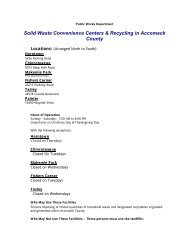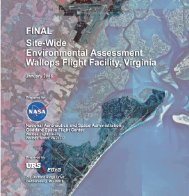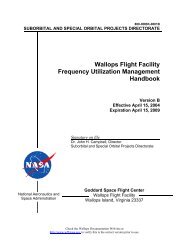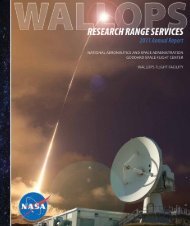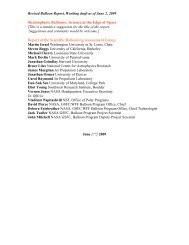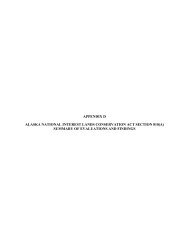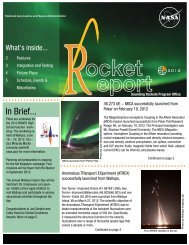Alternative Energy Draft EA - NASA Visitor Center at Wallops Flight ...
Alternative Energy Draft EA - NASA Visitor Center at Wallops Flight ...
Alternative Energy Draft EA - NASA Visitor Center at Wallops Flight ...
You also want an ePaper? Increase the reach of your titles
YUMPU automatically turns print PDFs into web optimized ePapers that Google loves.
SECTION TWO: PROPOSED ACTION AND ALTERNATIVES<br />
Proposed Action and <strong>Altern<strong>at</strong>ive</strong>s<br />
A study conducted for WFF (James Madison University, 2005) found th<strong>at</strong> a single 1.5 MW wind<br />
turbine would produce approxim<strong>at</strong>ely 15 percent of the electricity required to oper<strong>at</strong>e WFF and<br />
would easily interconnect to WFF’s distribution system. Following this study, <strong>NASA</strong> performed<br />
its own electrical system evalu<strong>at</strong>ion and determined th<strong>at</strong> based on its average electrical load,<br />
WFF could likely support two of the 1.5 MW wind turbines. Further investig<strong>at</strong>ion also led to the<br />
conclusion th<strong>at</strong> <strong>NASA</strong> could obtain 2.0 MW wind turbines for approxim<strong>at</strong>ely the same cost.<br />
WFF estim<strong>at</strong>es th<strong>at</strong> each 2.0 MW wind turbine would gener<strong>at</strong>e approxim<strong>at</strong>ely 5 GWh/year of<br />
electricity, for a total of 10 GWh produced annually. Therefore, to establish a means for<br />
reasonable comparison among renewable energy altern<strong>at</strong>ives in this <strong>EA</strong>, <strong>NASA</strong> standardized<br />
each altern<strong>at</strong>ive as having to produce an equivalent amount of electricity th<strong>at</strong> would be gener<strong>at</strong>ed<br />
by two 2.0 MW wind turbines (10 GWh/year).<br />
In addition, CEQ regul<strong>at</strong>ions require th<strong>at</strong> an agency “include the altern<strong>at</strong>ive of no action” as one<br />
of the altern<strong>at</strong>ives it considers (40 CFR 1502.14[d]). The No Action <strong>Altern<strong>at</strong>ive</strong> serves as a<br />
baseline against which the impacts of the Proposed Action and <strong>Altern<strong>at</strong>ive</strong>s are compared.<br />
2.1 RANGE OF ALTERNATIVES CONSIDERED FOR RENEWABLE ENERGY<br />
Several sources of renewable energy were considered for the <strong>Altern<strong>at</strong>ive</strong> <strong>Energy</strong> Project<br />
including wind, solar, tidal, wave, and geothermal power.<br />
2.1.1 Wind Power<br />
Currently the world’s fastest growing renewable power source, wind energy is the transform<strong>at</strong>ion<br />
of wind into mechanical power through a turbine, which is then converted into electricity<br />
through a gener<strong>at</strong>or. Gener<strong>at</strong>ion of electricity by wind energy has the potential to reduce<br />
environmental impacts caused by use of fossil fuels to gener<strong>at</strong>e electricity because, unlike fossil<br />
fuels, wind energy does not gener<strong>at</strong>e <strong>at</strong>mospheric contaminants or thermal pollution.<br />
Figure 2 shows the major components of a typical wind turbine. The nacelle is the housing for<br />
the gear box and gener<strong>at</strong>or th<strong>at</strong> is mounted on top of the tower. Electronic controls rot<strong>at</strong>e the<br />
nacelle to face into the wind, and adjust the angle of the blades to regul<strong>at</strong>e rotor speed.<br />
According to studies performed by JMU (2005) and Iberdrola Engineering (2009), the average<br />
annual wind speed <strong>at</strong> <strong>Wallops</strong> Island in the loc<strong>at</strong>ion of the proposed turbines <strong>at</strong> a height of 48<br />
meters (157 feet) is 6.25 meters per second, and the prevailing wind direction is from the south<br />
and southwest.<br />
The Intern<strong>at</strong>ional Electrotechnical Commission (IEC), an intern<strong>at</strong>ional standards development<br />
organiz<strong>at</strong>ion, has developed a classific<strong>at</strong>ion system for the design conditions of wind turbine<br />
systems. There are 3 classes: Class I, II, and III, which specify the design wind speeds for a<br />
specific turbine product. The wind resource classific<strong>at</strong>ion <strong>at</strong> <strong>Wallops</strong> Island is Class IIa.<br />
Based on the measured wind speeds and predicted long-term wind speeds, direction of the wind<br />
resource, the IEC wind classific<strong>at</strong>ion (IIa), and other factors such as air density, Iberdrola (2009)<br />
determined th<strong>at</strong> <strong>Wallops</strong> Island has adequ<strong>at</strong>e wind resources for oper<strong>at</strong>ion of utility-scale wind<br />
turbines.<br />
7



